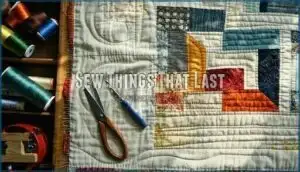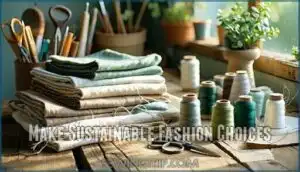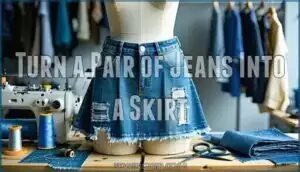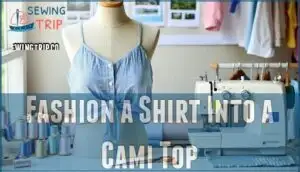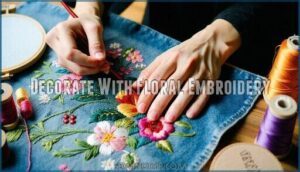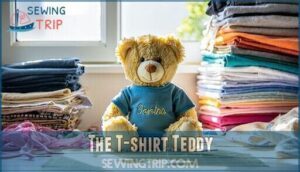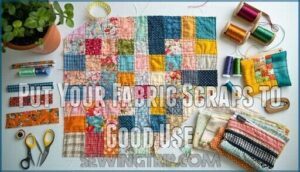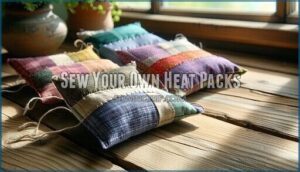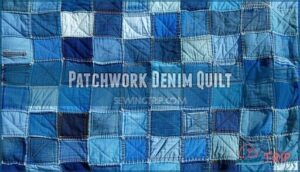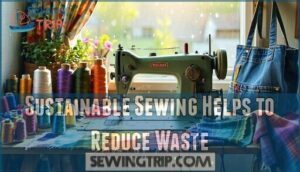This site is supported by our readers. We may earn a commission, at no cost to you, if you purchase through links.
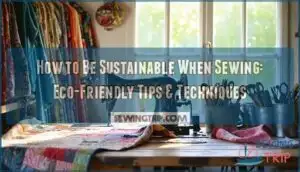
Start with organic cotton or linen instead of synthetic materials. Transform worn jeans into skirts or old shirts into trendy tops.
Keep fabric scraps for patches, quilts, or small accessories. Invest in quality tools that’ll last years rather than cheap ones you’ll replace.
Choose natural dyes over chemical ones when possible. Repair clothes instead of discarding them.
Buy fabric from local suppliers to reduce shipping impact. These small changes create a ripple effect that benefits both your wallet and the planet while fostering your creativity in unexpected ways, and being sustainable is key to a better future with quality tools.
Table Of Contents
- Key Takeaways
- Find Your Sustainability Priorities
- Sew Things That Last
- Make Sustainable Fashion Choices
- Upcycling – The Trend That Will Never Get Old
- Even More Sustainable Sewing Ideas
- Sustainable Sewing Helps to Reduce Waste
- Make Eco-friendly Fashion Choices With Gudrun Sjöden
- Frequently Asked Questions (FAQs)
- Conclusion
Key Takeaways
- Choose sustainable fabrics – You’ll want to pick organic cotton, hemp, linen, or recycled materials instead of synthetic options to reduce environmental impact.
- Upcycle and repurpose existing items – Transform old jeans into skirts, shirts into cami tops, and fabric scraps into useful items like heat packs or pot holders.
- Focus on durability over speed – Use quality construction techniques, reinforced seams, and adjustable elements so your handmade pieces last for years.
- Practice zero-waste methods – Save every fabric scrap, use zero-waste patterns, and repair clothes instead of discarding them to minimize textile waste.
Find Your Sustainability Priorities
Before diving into sustainable sewing, you need to identify your personal sewing values. What drives your passion for creating handmade pieces? Perhaps it’s reducing environmental impact, supporting ethical fabrics, or expressing your creativity through upcycling projects.
Start by writing down your sustainable sewing goals. Do you want to minimize waste, choose organic materials, or support fair-trade businesses? Your personal goals will guide every fabric choice and project decision.
Consider realistic practices that fit your lifestyle and budget. You don’t need to overhaul everything at once. Maybe you’ll begin by using fabric scraps for small projects or investing in quality tools that last longer. One option is to think about recycled polyester fabrics for certain projects.
Remember that sustainable practices look different for everyone. Some sewers prioritize ethical fabrics while others focus on creative expression through repurposing old garments. Find your sweet spot between environmental consciousness and the joy of creating. This foundation will shape your entire approach to sewing for sustainability.
Sew Things That Last
When you’re sewing for sustainability, durability matters more than speed.
Quality over quantity – every stitch should stand the test of time.
Choose quality construction techniques and thoughtful design elements that help your handmade pieces withstand regular wear and washing for years to come, which is crucial for durability.
Techniques for Durability
Building lasting garments starts with smart construction choices.
Seam reinforcement through flat felled seams and bartacking reduces failure rates by 60%. Quality fabrics with higher thread counts offer superior durability for sustainable sewing techniques.
Consider these mindful construction approaches:
- Use adjustable elements like elastic waistbands and wider seam allowances for flexibility
- Apply proper seam finish techniques such as French seams to reduce fraying by 70%
- Master visible mending skills to extend garment life through creative patching
Quality fabric selection forms your foundation. Choose materials with proven longevity over cheaper alternatives. These sewing techniques create lasting projects that withstand years of wear while supporting your sustainability goals.
Reducing Waste
Through careful planning and zerowaste methods, you can transform your fabric stash into something meaningful.
Zero-waste patterns use every inch of material while mending techniques breathe new life into worn garments.
Your sewing scraps become treasures through upcycling projects like heat packs or pot holders.
Biodegradable materials reduce landfill impact when projects reach their end.
Smart fabric scrap use means stuffing pet toys with small pieces or creating patchwork quilts from larger remnants.
One can even explore wedding dress alterations for repurposed embellishments.
Waste reduction starts with intentional cutting and creative problem-solving.
Make Sustainable Fashion Choices
Several smart fabric choices can transform your sustainable sewing practice. Choose organic cotton, bamboo, hemp, or recycled polyester for your next project. These sustainable fabrics reduce environmental impact while supporting ethical fashion principles.
Ethical fabric sourcing matters. Look for suppliers who practice fair labor standards and environmentally responsible manufacturing. The slow fashion movement encourages thoughtful purchases over impulse buying.
Consider garment lifecycle impact when selecting materials. Quality fabrics last longer and reduce waste. Conscious consumerism means buying less but choosing better materials. For example, consider organic cotton options to avoid harmful pesticides.
Build a minimalist wardrobe with versatile pieces. Select organic thread and plant-based interfacing for notions. Shop thrift stores for second-hand textiles. These sustainable fashion choices support both your creativity and environmental goals.
Upcycling – The Trend That Will Never Get Old
Upcycling transforms old clothes into fresh new pieces without buying new materials. You’ll extend garment lifespans while reducing textile waste and creating unique fashion statements that reflect your personal style.
Transform yesterday’s wardrobe into tomorrow’s treasures through the timeless art of upcycling.
Turn a Pair of Jeans Into a Skirt
With a simple pair of scissors and some creativity, you can transform old jeans into a stylish denim skirt. This sustainable sewing project breathes new life into worn denim while reducing textile waste.
- Measure and mark your desired skirt length on the jeans
- Cut along the inseam and side seams to create flat panels
- Reinforce cut edges with overlock or zigzag stitching for durability
- Shape the panels into your preferred denim skirt style (A-line, pencil, or flared)
- Add closure options like button plackets, zippers, or elastic waistbands
- Position pockets strategically for both function and visual appeal
This denim upcycling technique transforms recycled fabrics into wearable fashion. You’ll create unique upcycled clothing while mastering seam reinforcement tips.
Consider using denim quilt patterns for added inspiration. Use fabric scraps from trimming for small projects like patches or appliqués. Each repurposed piece reduces waste and showcases your sustainable sewing skills.
Fashion a Shirt Into a Cami Top
Transform old shirts into trendy cami tops through strategic cutting and creative styling.
Choose flowy blouses or fitted t-shirts for your shirt transformations.
Cut straight across below the armholes to create the basic cami shape.
Add tie-front details or asymmetrical hems for unique cami styles.
This creative repurposing extends garment life while embracing sustainable fashion.
Your DIY clothing projects reduce waste through refashioning existing pieces.
These sustainable sewing projects prove that upcycled clothing can be both stylish and eco-conscious using sustainable fabrics you already own.
Decorate With Floral Embroidery
Hand-stitched flowers breathe new life into worn garments.
Choose embroidery stitches like backstitch and satin stitch for floral patterns.
Mix thread types and color palettes to create eye-catching designs on sustainable fabrics.
This ecofriendly sewing technique transforms fabric scraps into decorative elements.
Floral embroidery adds personality while extending garment life through sustainable sewing practices.
Naturally Dye Your Fabrics
Natural plant-based dyes transform old fabrics into vibrant pieces while reducing environmental impact.
Kitchen scraps like avocado pits and turmeric create beautiful sustainable dyes without toxic chemicals.
For those seeking natural dye products, many options exist.
- Dye sources: Onion skins yield golden yellows while black walnut hulls produce rich browns
- Mordant alternatives: Use vinegar or soy milk instead of harsh chemicals for colorfastness methods
- Dyeing techniques: Solar dyeing outdoors reduces energy consumption by 40% compared to boiling processes
Spruce Up Your Pockets
Pocket embroidery transforms plain garments into statement pieces.
Add appliqués or contrasting fabric scrap pockets for instant personality.
Upcycled pocket swaps breathe new life into worn clothes.
Try pocket shape alteration by resizing or repositioning for better function.
Functional pocket design additions like zippers or snaps enhance utility.
These sustainable sewing projects turn forgotten pieces into treasured items while reducing waste.
Even More Sustainable Sewing Ideas
You can transform fabric scraps and old clothing into practical items that reduce waste while serving your daily needs.
These creative projects help you maximize every piece of fabric while building skills in sustainable sewing techniques, which can help you develop expertise in reducing waste and creating useful items.
Tie Dye Your Home
Frequently, old duvet covers and towels become perfect canvases for tie dye experiments.
You can transform these forgotten textiles into vibrant DIY decor pieces that bring new energy to your living space.
Choose sustainable fabrics like cotton or linen for the best color absorption. Start with simple pattern techniques using rubber bands or string to create circles and stripes.
Select color palettes that complement your existing home decor. Dyeing bedding creates unique focal points while practicing ecofriendly sewing methods.
This textile selection process helps you upcycle items that might otherwise end up in landfills.
The T-shirt Teddy
Turn that old t-shirt into a cherished keepsake with a homemade teddy bear! This sustainable sewing project transforms forgotten fabric into something special while teaching kids about upcycling.
Creating your tshirt teddy requires thoughtful fabric sourcing and planning for teddy durability:
- Select quality sustainable fabrics – Choose t-shirts with tight weaves and minimal wear for better longevity
- Add personalization options – Embroider names or special dates to increase sentimental value
- Consider gift sustainability – Use organic cotton stuffing alternatives like fabric scraps for eco-friendly filling
This simple upcycle project creates lasting memories while keeping textiles out of landfills.
Put Your Fabric Scraps to Good Use
Everyone has fabric scraps lying around after sewing projects. These remnants don’t need to become waste when you can transform them into useful items through creative applications.
Scrap organization helps you see what materials you have for small projects. Zero-waste sewing turns every piece into something functional.
| Project | Best Fabric Types |
|---|---|
| Travel pouches | Cotton, canvas, denim |
| Coasters | Felt, interfacing, quilting cotton |
| Pot holders | Heat-resistant cotton, terry cloth |
| Bookmarks | Silk, linen, decorative scraps |
Fabric waste reduction becomes simple when you upcycle scraps into practical items. You can create everything from kitchen accessories to storage solutions. This sustainable sewing approach keeps materials out of landfills while adding handmade touches to your home. Reducing waste and creating functional items is a key benefit of this approach.
Sew Your Own Heat Packs
Transform fabric scraps into microwave safe heat packs for sustainable sewing that serves your wellness needs.
This easy sewing project combines functional sewing with eco-friendly materials, turning leftover fabric into warming comfort. Many people source their microwaveable packs online if they don’t want to sew their own.
- Fabric Scrap Uses: Repurpose cotton or flannel remnants for microwave safe fabrics that withstand repeated heating
- Filling Material Options: Choose rice, flaxseed, or wheat berries as natural, biodegradable fillers for superior heat retention
- Aromatherapy Infusion: Add dried lavender or herbs sparingly for gentle fragrance without synthetic additives
- Heat Retention Tests: Test different fabric thicknesses to find the perfect balance between warmth and safety
- Sustainable Design: Create durable double-stitched seams that prevent spills and extend the heat pack’s lifespan
Patchwork Denim Quilt
With denim source materials from old jeans, create a stunning patchwork quilt that showcases sustainable sewing.
Plan your quilt design by cutting fabric scraps into geometric shapes for varied fabric combinations.
Use traditional patchwork techniques like raw-edge appliqué to secure layers.
This denim refashion project transforms worn clothing into an heirloom piece, proving that upcycle methods enhance quilt longevity while reducing textile waste.
Sustainable Sewing Helps to Reduce Waste
Your sustainable sewing journey doesn’t end with creative upcycling projects. Every stitch you make can actively combat textile waste that fills our landfills.
Sustainable sewing transforms how you approach materials. Fabric scrapbusting turns leftover pieces into useful items like potholders or heat packs. Zero-waste patterns eliminate cutting waste entirely.
You’ll create sewn alternatives to disposable items while keeping textiles in circulation longer. Mending matters more than many realize. Visible repairs extend garment life by months.
Upcycled notions like buttons from old clothes reduce new purchases. Zero waste sewing means planning cuts carefully to use every inch of fabric. Consider this: household textile reuse can lower your carbon footprint by 24-32% per item.
Your fabric scraps become building blocks for quilts, bags, or home accessories. Each repurposed piece prevents textile waste from reaching landfills while creating something uniquely yours. You can find inspiration for many scrap projects online.
Make Eco-friendly Fashion Choices With Gudrun Sjöden
Looking beyond waste reduction efforts, partnering with sustainable brands like Gudrun Sjödén amplifies your eco-friendly fashion impact.
This Swedish designer champions ethical fashion through careful material selection and transparent production practices.
Gudrun Sjödén’s commitment to sustainable materials shines through her use of organic cotton, recycled fibers, and bamboo blends.
Her eco-friendly printing methods reduce chemical waste while maintaining vibrant colors.
Each garment receives clear sustainability labels, helping you make informed sustainable fashion choices.
The brand’s focus on timeless designs extends garment lifespan substantially.
Instead of trendy pieces that quickly go out of style, Gudrun creates flowing silhouettes and gentle patterns that remain relevant season after season.
This approach reduces consumption while building a lasting wardrobe.
When shopping sustainable brands, look for detailed environmental impact information in product descriptions.
Gudrun’s transparency about energy-efficient production and fair labor practices sets the standard for ecofriendly fashion.
Choose investment pieces that align with your sustainable sewing values.
Frequently Asked Questions (FAQs)
How to be sustainable in sewing?
Ever wondered if your sewing could make a real difference?
Start by picking natural or recycled fabrics, mend what you have, reuse scraps, and choose quality tools.
Every thoughtful choice you make helps our planet breathe easier.
How to sew sustainably?
Choose organic cotton, hemp, or linen fabrics.
Repair clothes instead of discarding them. Upcycle old garments into new pieces.
Use zero-waste patterns that minimize scraps. Invest in quality tools for durability.
What does sustainability mean in sewing?
Many think it’s just buying organic fabric, but true sustainability means aligning your sewing with your personal values.
Whether that’s reducing waste, supporting ethical brands, or creating durable garments that last.
How can sewing help me environmentally?
Sewing helps you reduce fashion waste by creating durable clothes that last longer. You’ll buy fewer new items while transforming old garments into fresh pieces through upcycling and repair.
What sewing machine brands are most environmentally friendly?
Unfortunately, there’s limited information about specific sewing machine brands‘ environmental initiatives.
BERNINA stands out as one brand that actively minimizes environmental burdens, recycles waste, and commits to sustainability practices.
You’ll find more eco-friendly impact through buying quality second-hand machines rather than focusing on brand alone, which can help minimize environmental burdens and support eco-friendly choices.
How do I dispose of old sewing supplies responsibly?
Check with local recycling centers for fabric scraps and metal notions.
Donate usable supplies to schools, community centers, or sewing groups.
Repurpose old thread spools as organizers and broken scissors for craft projects, which can also help to repurpose old items.
Can I make my own sustainable sewing patterns?
Zero-waste patterns eliminate 15% more fabric waste than traditional designs.
You can absolutely create your own sustainable patterns using mathematical precision and creative problem-solving.
Start by drafting basic blocks, then modify them to utilize every fabric scrap efficiently, which is a key aspect of zero-waste designs.
What are the best natural alternatives to synthetic threads?
You’ll love organic cotton thread, silk, linen, and hemp threads as natural alternatives. These biodegradable options offer excellent strength and durability while reducing environmental impact compared to polyester threads.
How do I start a clothing swap for sewers?
Like planting seeds in fertile soil, you’ll start by reaching out to local sewing circles and fabric shops to gauge interest.
Create a simple registration system and set clear swap rules for fabric quality and quantity.
Conclusion
Transform your sewing space into an eco-warrior’s paradise that’ll make Mother Earth sing! Learning how to be sustainable when sewing isn’t just trendy—it’s essential for our planet’s future.
You’ve discovered that small changes create massive impacts. Choose organic fabrics over synthetic ones. Upcycle old clothes into fresh pieces. Save every fabric scrap for future projects.
Buy quality tools that last decades. Support local suppliers whenever possible. These simple steps reduce waste while boosting your creativity and saving money, which is a key aspect of being a sustainable sewer and an eco-warrior.
- https://www.mh-chine.com/blog/products/eco-friendly-sewing-materials-2025
- https://pmc.ncbi.nlm.nih.gov/articles/PMC7796070/
- https://craftsing.com/zero-waste-sewing-techniques/
- https://www.epa.gov/facts-and-figures-about-materials-waste-and-recycling/textiles-material-specific-data
- https://missyrose.com.au/blogs/news/the-benefits-of-sewing-your-own-clothes-why-its-the-better-choice

